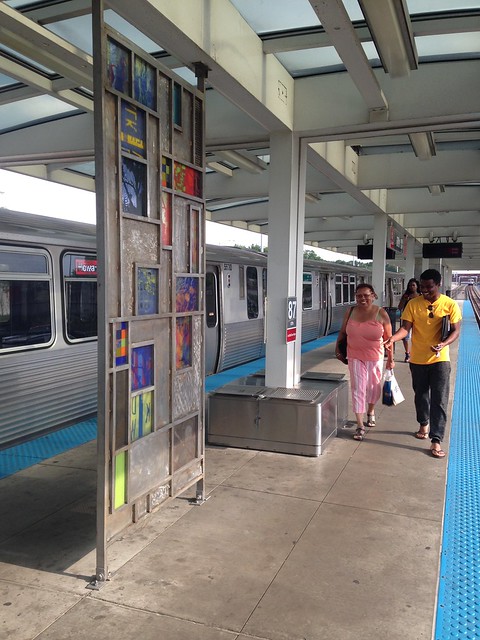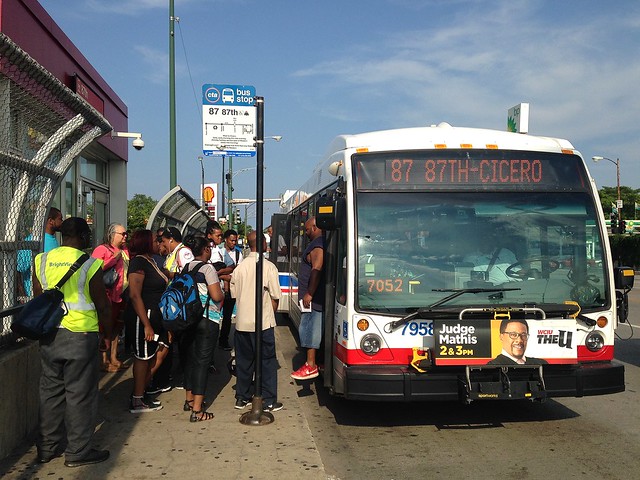[Last fall the Chicago Reader launched a new weekly transportation column written by Streetsblog Chicago editor John Greenfield. This partnership allows Streetsblog to extend the reach of our livable streets advocacy. We syndicate a portion of the column on the day it comes out online; you can read the remainder on the Reader’s website or in print. The paper hits the streets on Thursdays.]
Chicago's 'L' system, with its iconic train cars, relatively fast speeds, and occasionally breathtaking views, is the sexier side of the CTA. But the city's grid of 130 bus routes is really the meat and potatoes of our transit network, with 274.3 million boardings in 2015 compared to the train system's 241.7 million trips.
Bus service is especially important on the far south side, where access to other forms of public transportation is limited; although the city extends as far south as 138th Street, the Red Line terminates at 95th, and the Divvy bike-share coverage area currently stops at 79th.
To get a sense of what it's like riding buses on the far south side—and whether residents are satisfied with the level of service or feel that improvements are needed—last week I rode the entire route of the 87th Street bus, the southernmost bus line to cover a continuous east-west path across the entire width of the city.
The #87 runs ten miles, from Cicero Avenue in the quaintly named southwest suburb Hometown (near Oak Lawn) east to Buffalo Avenue in the hardscrabble South Chicago neighborhood. On the return trip the route dips south on Buffalo to 91st Street, heads west to Commercial Avenue, then back up to 87th. The route connects with the Red Line as well as Metra's Rock Island and Electric District lines, which contributes to the route's popularity—an average of nearly 13,000 people ride the 87th Street bus each weekday, according to the CTA. Except for Hometown, which is 97 percent white according to the U.S. Census, and South Chicago, which is about one-fifth Latino, just about all of the communities served by the bus line are solidly African-American.

I started my bus excursion around 5:30 PM on a Tuesday at the 87th Street Red Line stop, which was renovated in 2013 as part of the Red Line South reconstruction. Eighty-seventh Street’s narrow sidewalks were crowded with CTA customers waiting for buses.
I buttonholed one westbound young woman to ask about her commute. She declined to give her name, but explained that she commutes from her home near 87th and Ashland in Auburn-Gresham to her job as a downtown security guard. She takes the #87 to the Red Line, then rides north to her job near State and Lake. The journey takes about an hour, she said, and overall she's satisfied with the bus.
"During rush hour it's pretty frequent—although when I get off late the buses only run every 15 or 20 minutes," she said.
When the next westbound bus appeared, I piled on with about a dozen other people, including a young man with dreads listening to headphones, an older woman with two young children, and a smiling middle-aged guy in a blue suit who clasped palms with the driver in a soul handshake. Soon we were rolling down the broad lanes of 87th Street, passing big-box stores, bungalows, and apartment buildings.
Over the next two miles the bus emptied out. I chatted with 41-year-old passenger Carol Smith, who told me she was on her way home to 87th and Damen from her job as a receptionist at Northwestern Memorial Hospital. Smith usually drives to work, she said, despite the fact that garage parking in Streeterville costs about $20 a day. But her car was in the shop at the time, so that morning she'd taken the #87 to the Red Line to Chicago Avenue and walked the rest of the way. The total commute took about an hour and 15 minutes, she said.
As we talked, we realized that the bus had been stopped at Wood Street for an inordinately long time for no apparent reason. Almost ten minutes went by before we finally started moving again. When I asked about the delay, the driver explained that he'd stopped because he was running ahead of schedule and didn't want to cause "bus bunching," the annoying phenomenon in which customers wait an eternity for a ride only to have two or more buses show up at the same time.





